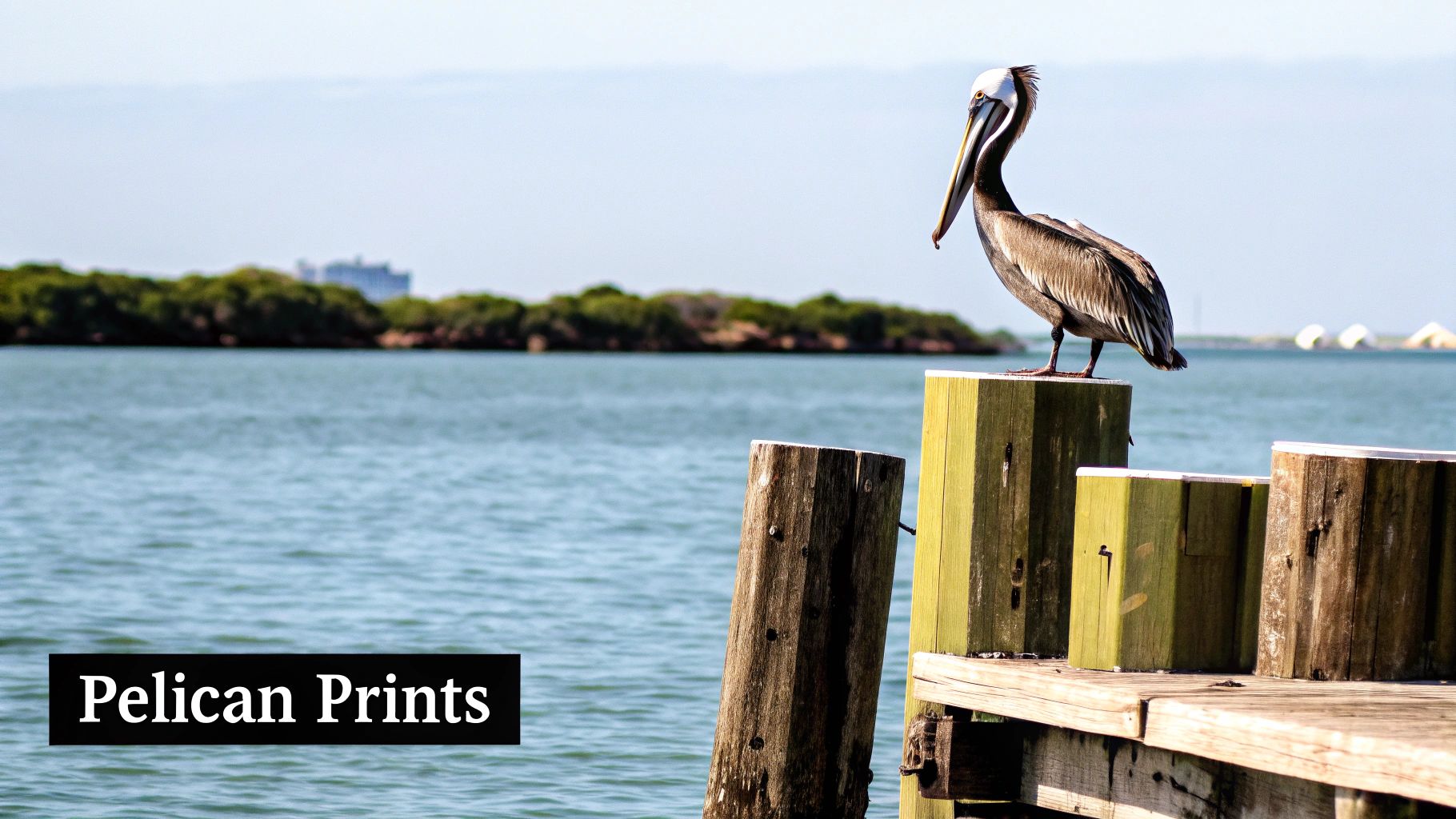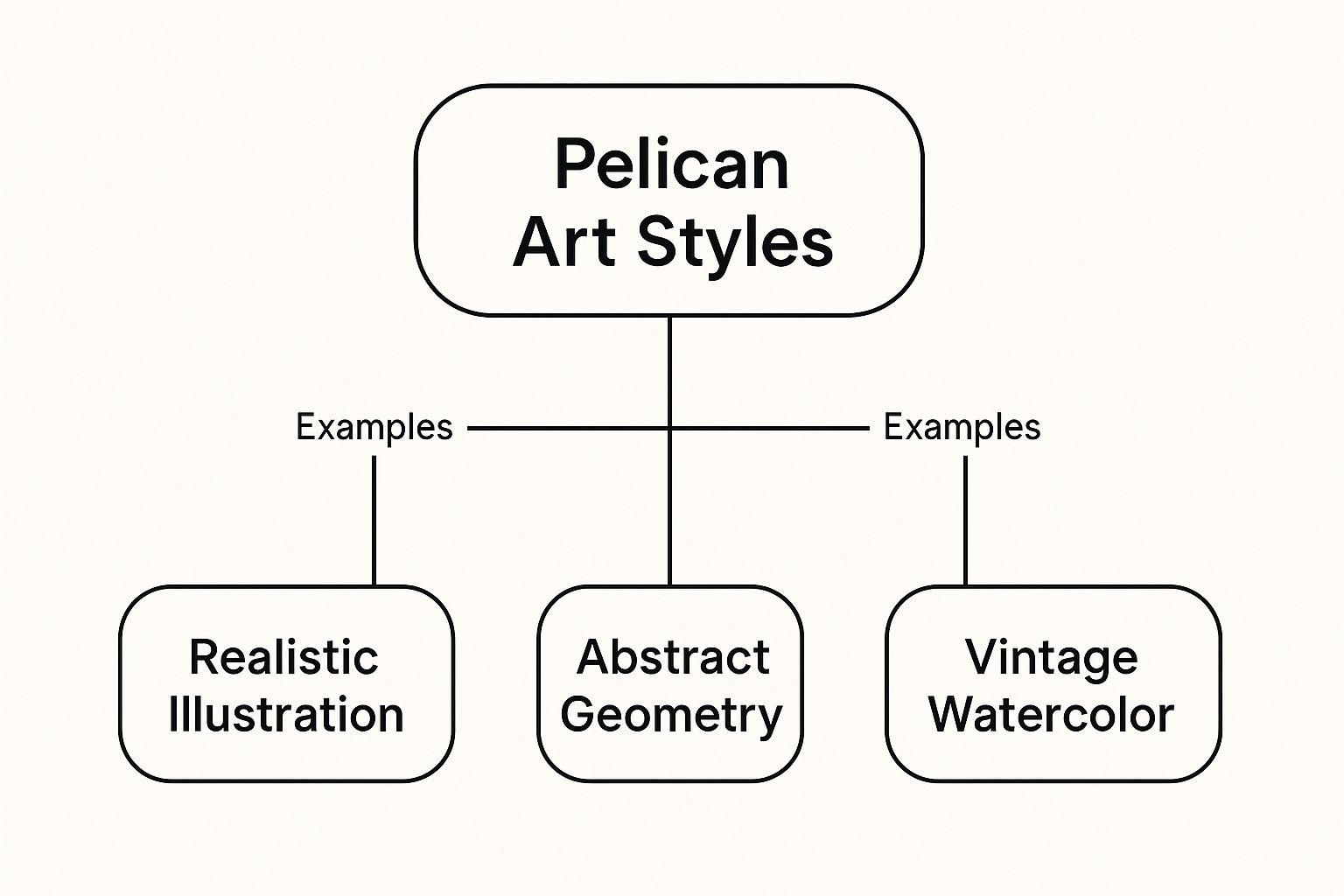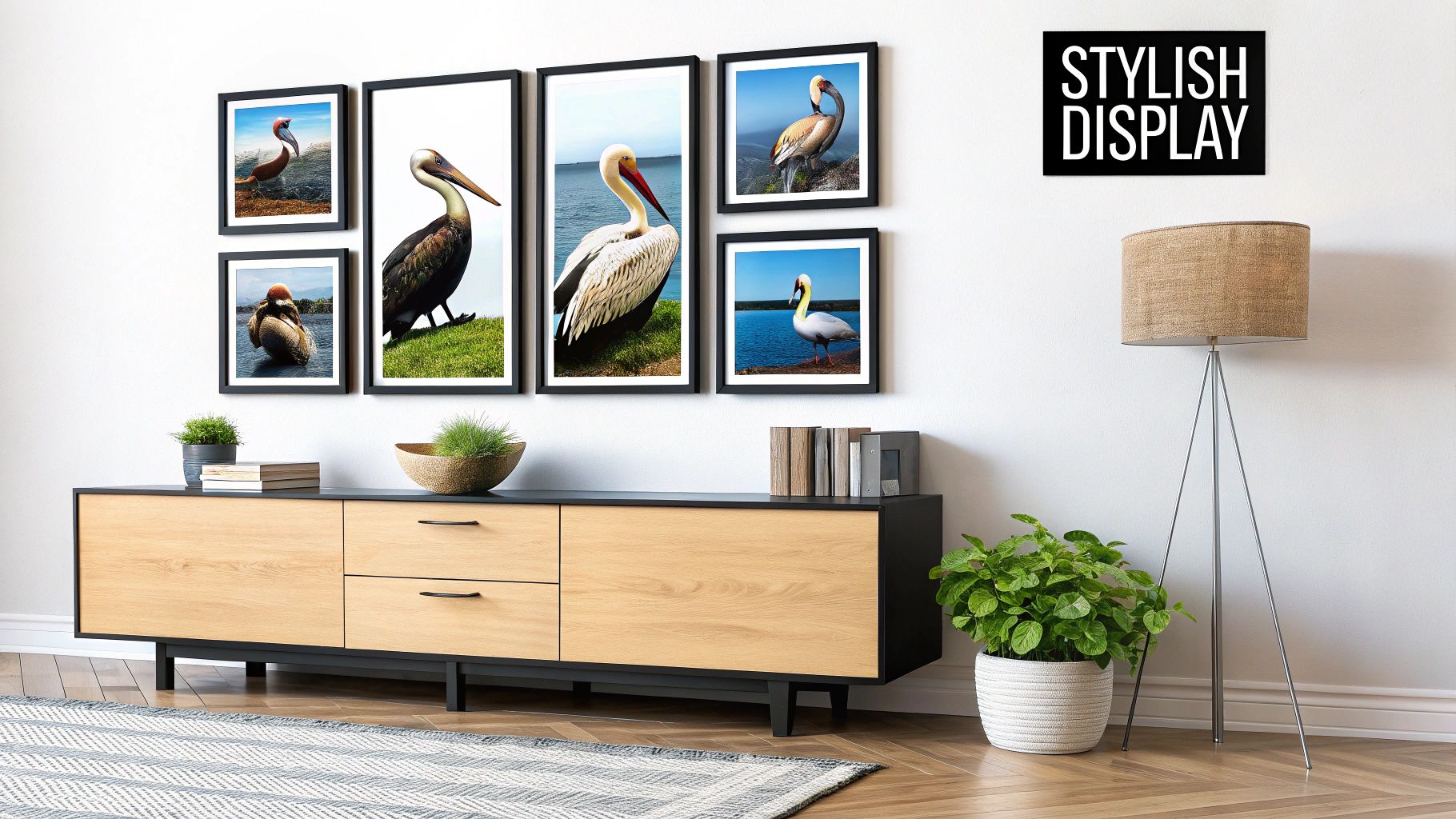There's just something about a pelican, isn't there? They're more than just a bird; they're a feeling. A pelican art print captures that whole vibe—the tranquility, the quiet resilience, and the easy-going rhythm of life by the sea.
With one simple piece of art, you can bring the essence of coastal charm right into your home, turning any room into a serene, ocean-inspired escape.
Why Pelican Art Is the Heart of Coastal Charm

Ever notice how a picture of a pelican can instantly make a space feel calmer, as if you can almost hear the waves? It's because these birds perfectly embody that unique coastal blend of quiet strength and absolute peace. They're true icons of the shoreline, reflecting the patient, steady nature of the ocean itself.
Bringing a pelican print into your decor is like installing a window with a permanent coastal view, no matter how far from the shore you might be. It becomes a daily reminder of gentle waves, salty air, and that unhurried pace we all crave. It's this deep connection that makes pelican art a cornerstone of any good coastal or nautical theme.
What Pelicans Really Represent
It goes deeper than just looking good on a wall. Pelicans carry a symbolic weight that really resonates with people. Think about it:
- Resilience: These birds are survivors. They weather fierce coastal storms and thrive in tough environments. A piece of pelican art can be a beautiful, subtle reminder of your own enduring strength.
- Tranquility: There's nothing quite like watching a pelican glide silently over the water or rest on a piling. That profound sense of calm is effortlessly infused into any room where the art hangs.
- Community: Pelicans are social birds, often found in groups. They symbolize the importance of social bonds and sticking together.
This growing appreciation for decor with real meaning is making a big splash in the art world. The global wall art market was valued at around $63.61 billion in 2024 and is expected to soar to $118.79 billion by 2032. Unique pieces like distinctive pelican wall art paintings are a huge part of that growth. If you're curious, you can dig into the numbers over at Fortune Business Insights.
A pelican print doesn't just decorate a wall; it sets a mood. It tells a quiet story of peaceful shores and enduring nature, making it a timeless addition to any space in need of some coastal elegance.
Exploring Different Pelican Artwork Styles
When you think of "pelican art," what comes to mind? For a lot of people, it's a single, classic image. But the truth is, the world of pelican art is incredibly vast and varied, with a style to match pretty much any personality or room.
Choosing the right print is less about the bird itself and more about the feeling you want to bring into your space. It's a lot like choosing music. A highly detailed, realistic painting is like a classical symphony—full of precision, nuance, and technical skill. An abstract piece, on the other hand, is more like improvisational jazz; it’s all about capturing a feeling and an energy, not just a literal shape. Each style tells a completely different story.
This image below gives a great snapshot of how artists approach this iconic coastal bird.

As you can see, the interpretations branch out quite a bit, from photorealistic to vintage, each one creating a totally unique experience for your home.
Capturing Reality with Photorealism and Illustration
Photorealistic pelican art prints are all about capturing the bird in stunning, lifelike detail. If you’re a nature lover who gets lost in the intricate beauty of wildlife, this style is for you. We're talking every single feather, the unique texture of that famous beak, and the unmistakable glint in the pelican’s eye, all rendered with unbelievable accuracy.
This style is a perfect fit for spaces that feel calm, natural, and maybe even a little bit studious—think a home office, a bright sunroom, or a classic living room. It's an invitation to look closer, to appreciate the bird as if it were right there in the room with you. It’s like having a window into the natural world, offering a quiet moment of admiration.
The Energy of Abstract Pelican Art
Swinging to the other end of the spectrum, you have abstract pelican prints. These pieces don't aim for a perfect copy; instead, they use color, shape, and form to express the essence of the pelican. An artist might use bold, sweeping brushstrokes to show a pelican in flight or use geometric shapes to deconstruct its form into something new and exciting.
Abstract art is a fantastic choice for modern, minimalist, or eclectic interiors—anywhere you want to make a statement. It injects a room with a dynamic burst of energy and color, sparking conversation and offering a more contemporary spin on coastal decor. Instead of just seeing a bird, you feel its grace and power.
An artist’s style is their unique language for telling a story. A realistic print documents the pelican’s existence, while an abstract one interprets its spirit. The best choice is the one that speaks your language.
The Timeless Charm of Vintage and Minimalist Styles
Of course, there’s a whole world of art that sits between those two extremes. Vintage-inspired prints often have the look of old scientific illustrations or classic seaside postcards, bringing a wonderful sense of nostalgia and timeless elegance to a room. They feel right at home with traditional, farmhouse, or shabby-chic decor.
Then there's minimalist line art, which uses nothing more than clean, simple lines to create the pelican's iconic silhouette. This understated approach is perfect for Scandinavian-inspired or contemporary spaces where simplicity is key. These prints prove that sometimes, less really is more, creating a powerful impact with just a few well-placed lines.
Comparing Pelican Art Print Styles
To help you find the perfect match for your home's aesthetic, this side-by-side comparison breaks down the most common pelican art styles.
| Art Style | Key Characteristics | Best For... | Mood Created |
|---|---|---|---|
| Photorealism | Highly detailed, true-to-life accuracy, and focuses on texture. | Traditional spaces, studies, or anyone wanting a realistic wildlife feel. | Calm, observational, and natural. |
| Abstract | Bold colors, expressive brushstrokes, and non-literal shapes. | Modern, eclectic, or minimalist rooms that need a pop of energy. | Dynamic, emotional, and vibrant. |
| Vintage | Muted color palettes, aged paper textures, and scientific illustration feel. | Farmhouse, shabby-chic, or traditionally styled homes. | Nostalgic, charming, and timeless. |
| Minimalist | Simple lines, negative space, and a focus on form and silhouette. | Scandinavian, modern, or contemporary interiors. | Clean, sophisticated, and serene. |
Ultimately, the right style is the one that connects with you and complements the story you're trying to tell in your home. Whether you want a calming window to nature or a vibrant splash of energy, there's a pelican print out there waiting for you.
How to Choose the Right Pelican Print

So, you’ve decided a pelican print is just what your space needs. Awesome! But finding the perfect one is a bit more involved than just picking the first image that catches your eye. It’s about making a choice that feels intentional and truly elevates the room.
Think of it like casting the lead role in a play. Your room is the stage, your decor is the set, and the pelican print is the star. You want everything to work together to create a cohesive and beautiful scene. Let's walk through how to pick a piece that doesn't just hang on a wall, but feels like it was always meant to be there.
Getting the Size and Scale Just Right
First things first, let’s talk size. This is where so many people go wrong. A tiny print floating in the middle of a huge, empty wall can look like an afterthought. On the flip side, an enormous piece in a cramped hallway can make the whole space feel crowded.
A good rule of thumb I always share is to have your art fill about two-thirds to three-quarters of the empty wall space above a piece of furniture, like your sofa or the headboard of your bed.
- Got a big, open wall? Go for it! A single, large-scale pelican print can create a stunning focal point. A gallery wall featuring a few smaller pieces also works wonders here.
- Working with a smaller spot? Think hallways, nooks, or that awkward wall in the kitchen. A smaller, more intimate print or a pair of vertical prints (a diptych) can add a ton of personality without overwhelming the area.
Playing with Your Color Palette
Okay, now for the fun part: color. Your new pelican print needs to have a conversation with the colors already in your room. They don't have to match perfectly—in fact, sometimes it's better if they don't! The goal is harmony.
If your room has a soft, coastal vibe with lots of blues and beiges, a print with similar serene tones will feel right at home. But what if your room is mostly neutral? That’s your chance to introduce a splash of energy! A vibrant, abstract pelican with bold colors could be the exact pop your space is craving.
Your artwork shouldn't just match your decor; it should elevate it. Use the colors in a pelican print to either tie the room together or to introduce an exciting new accent that draws the eye.
Choosing the Right Print Material
Last but not least, let's consider the material. The surface your pelican art is printed on makes a huge difference in its overall look and feel. Each option has its own personality.
- Canvas Prints: These have a classic, slightly textured feel that gives the art warmth and dimension, much like a real painting. You can even hang them without a frame for a clean, modern look.
- Fine Art Paper: If you love crisp details, this is for you. It has a smooth, matte finish that makes every little line in an illustration or photograph pop. You'll want to frame this one behind glass to protect it.
- Metal or Acrylic Prints: For a super sleek, contemporary vibe, these are fantastic. The colors are incredibly vibrant, and the glossy finish makes a bold statement. They're also really durable.
Nailing down the material is that final touch that ensures your new pelican print looks incredible and remains a piece you'll love for years to come.
Styling and Hanging Your Pelican Wall Art

So, you’ve found the perfect pelican art print—the one that really speaks to you. Awesome! Now for the fun part: making it a true centerpiece in your room. This is where you get to turn that print into a statement, transforming a blank wall into a canvas for your personal style.
Whether you're working with one dramatic piece or a whole flock of smaller prints, where you put it makes all the difference. It’s not just about finding an empty spot on the wall. It’s about creating a visual story that feels right for your space and brings that coastal vision to life.
Let’s dive into how to hang your new artwork like a pro.
Create a Stunning Focal Point
A single, large-scale pelican print can be incredibly powerful. When you place it just right, it becomes an instant focal point, drawing the eye and setting the tone for the whole room. Think of it as the anchor that holds all your decor together.
This approach works beautifully in those key spots where you really want to make an impact.
- Above the Sofa: Center a large horizontal print over your living room sofa. It just feels right, creating a balanced and inviting atmosphere.
- Over the Bed: A serene pelican art print hanging above your headboard can turn your bedroom into a peaceful coastal escape.
- In the Dining Room: Go bold and place a dramatic piece on the main wall of your dining area. It's an instant conversation starter.
The key is to give the artwork some breathing room. Let its presence command attention without completely overwhelming the space.
The Art of the Gallery Wall
Have a few smaller prints you love? A gallery wall is a fantastic way to show them off. This is your chance to mix and match different styles, sizes, and orientations of pelican art prints to create a display that’s totally you. It’s like composing a visual symphony with your favorite pieces.
The secret to a great gallery wall isn't perfection; it's balance. My advice? Lay everything out on the floor first. Play around with different layouts until you find one that feels cohesive and interesting before you put a single nail in the wall.
For a modern, clean look, stick with matching frames and arrange them in a neat, symmetrical grid. If you’re leaning more towards an eclectic, bohemian vibe, mix up the frame styles and create a more organic, flowing arrangement. You could even build your collection around a beautiful 8x10 pelican wall art print, combining it with other coastal-themed pieces to tell a richer story.
Essential Hanging and Framing Tips
Don't rush the final steps—hanging and framing are what tie it all together. One of the most common mistakes I see is people hanging their art way too high. A good rule of thumb is to hang the center of your piece at eye level, which is usually around 57-60 inches from the floor. This creates a much more intimate and connected viewing experience.
And let's talk about the frame. The right frame does so much more than just protect your print; it actually enhances it. A rustic wooden frame can amplify the charm of a vintage-style pelican print, while a sleek, minimal metal frame can make an abstract piece feel even more contemporary. The frame truly is the finishing touch that elevates your print from a simple picture to a true work of art.
The Allure of Limited Edition Pelican Prints
When you're ready to move beyond mass-produced posters, a whole world of art opens up—art that feels more personal, more meaningful, and often, more valuable. This is where limited edition pelican art prints come in. They offer a fantastic way to own something truly special, a piece that has a story and a direct connection to the artist who brought it to life.
But what exactly does "limited edition" mean? Think of it like a special batch of a craft beer versus the stuff you find in every supermarket. The artist decides to create only a specific, fixed number of prints. Once that number—say, 50 or 100—is sold out, that's it. No more are ever made. This built-in scarcity is what makes each print feel so much more exclusive.
The Value of Scarcity and a Signature
Knowing you're one of only a handful of people in the world to own a particular piece of art is a pretty special feeling. It's the difference between hanging a decoration and displaying a collectible. This exclusivity often means the print can become more valuable over time, but more importantly, it makes it more valuable to you.
Many of these prints are also hand-signed and numbered by the artist (you'll see something like "12/100" in the corner). That little signature is a powerful thing. It creates a tangible link between you and the person who poured their heart into the work, turning a beautiful image into a small piece of their artistic journey.
Owning a limited edition print is like having a secret. It’s a shared piece of the artist's vision that only a small circle of collectors gets to experience, making your connection to the art deeper and more personal.
This isn't a new trend, either. It has a rich history rooted in the masters. Take John James Audubon's iconic painting of the Brown Pelican from 1832. It's a cornerstone of avian art, and the highly sought-after Princeton Edition reproductions are museum-quality prints. They were limited to just 1,500 hand-numbered copies, preserving a piece of artistic legacy for generations. You can dive deeper into Audubon's work on the Brown Pelican to see its historical significance.
Modern Artists and Accessible Exclusivity
Today, that same spirit of exclusivity is alive and well, and it's more accessible than ever. Talented artists are releasing small, carefully curated collections of their work on platforms like Etsy or through their own online galleries, like William Tucker Art.
This modern approach lets you support a living artist directly while bringing home a piece that feels both current and timeless. When you choose a limited edition print, you're doing more than just buying art—you're investing in a story, celebrating an artist's craft, and adding a touch of authentic charm to your coastal-inspired home.
How to Protect and Care for Your Artwork
You've brought a beautiful pelican art print into your home, and it’s more than just decor—it's an investment in your space's coastal charm. A little bit of care will go a long way in making sure it stays as stunning as the day you got it.
Think of it like a nice piece of wooden furniture. You wouldn't leave it out in the rain, right? Your artwork needs the same kind of thoughtful protection from its own set of environmental enemies.
The two biggest culprits that can damage a print are direct sunlight and humidity. The sun's UV rays are notorious for fading vibrant colors over time, just like they do to outdoor cushions. At the same time, high humidity—the kind you find in steamy bathrooms or kitchens—can cause paper to warp and can even lead to mold.
Smart Placement and Handling
Your first line of defense is simply choosing the right spot on the wall. A little forethought here can prevent a world of headaches later.
- Avoid Direct Sunlight: An interior wall is almost always a safer bet than one directly across from a big, bright window.
- Steer Clear of Moisture: Keep your prints out of bathrooms and kitchens, unless you have fantastic ventilation. Damp basement walls are also a no-go.
- Mind the Temperature: Try not to hang art directly over radiators or fireplaces. Those constant, extreme temperature swings can really stress the materials.
When it's time to clean, remember that less is more. You definitely don't need harsh chemicals or anything abrasive.
Treat your artwork with the same gentle touch you'd use on a delicate old photograph. You're just dusting, not scrubbing. A light, regular dusting is so much better than an aggressive deep clean.
Simple Cleaning Techniques
For a canvas print, all you really need is a soft, dry microfiber cloth or a classic feather duster. Just give the surface a gentle wipe to get rid of any dust that's settled. Never, ever use water or cleaning sprays directly on the canvas—it can leave streaks or even damage the protective coating.
If your pelican print is framed behind glass, you have a bit more leeway. The key is to spray a little glass cleaner onto your microfiber cloth, never directly onto the glass itself. This is a pro tip! Liquid can easily seep behind the frame and damage the print permanently. Give it a gentle wipe, and your art will be back to looking its best.
At William Tucker Art, we create pieces designed to last. Explore our full collection of coastal and wildlife art that brings nature's beauty into your home. Discover your next masterpiece at williamtuckerart.com.
